The goal of tackling in rugby is to grab hold of players with the ball to stop, restrict, or reverse their momentum.
There are strict safety laws around tackling that I won’t go into here. Instead, I’ll review the different types of tackles in rugby.
There may be more than you think! Here is the list:
- head-on tackle
- side-on tackle
- smother tackle
- double tackle
- driving tackle
- the hit
- stationary tackle
- tackling the fend
- tackle from behind
- ankle tap
- chop tackle
- half tackle
- shirt grab
Head-On Tackle

A head-on tackle is required when the ball carrier is charging straight at the defender.
In other words, the tackle won’t be from the side or from behind.
The picture above shows the defender preparing to make a head-on tackle.
The defender lines up square to the attacker. Just before impact, he lowers his stance by bending his knees.
Leaning toward the attacker, the defender leads with the nearest shoulder. That’s the prop’s left shoulder in the picture.
As the defender drives forward with his legs, it’s vital that he aims his head to the side of the attacker’s body.
This avoids getting a head knock off the elbow or knee of the opponent.
The defender must wrap his arms around the ball carrier’s body.
If the arms aren’t wrapped, this is a “shoulder charge” instead of a legitimate rugby tackle. That is an offense in rugby. The sanction is a penalty kick, and possibly a yellow card.
At this point, the tackler’s momentum is coming through his shoulder to push the ball carrier backward. At the same time, the tackler’s arms are dragging the ball carrier downward.
The effect is that the attacker is forced backwards to the ground with the tackler landing upon him.
Evading head-on tackles
The challenge for the would-be tackler is that the attacker is trying to evade the tackle.
If the defender sets too early into a static position, the attacker will try to swerve or side-step past him.
Watching a light-footed back jink past a bamboozled flanker raises a massive cheer from one set of supporters in the stand!
Side-On Tackle
With the side-on tackle, the defender approaches from one side of the ball carrier.
The defender is still in front of the attacker, but the direction is diagonal instead of head-on.
The picture below shows one example as the defender is about to wrap his arms around the upper thighs of the attacker.
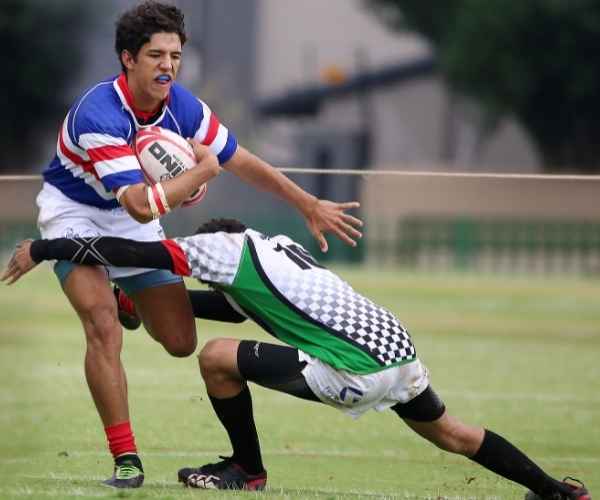
A key point I want to emphasize is that the tackler’s head is behind the nearest buttock of the ball carrier.
This is drummed into young players from the moment they start to play contact rugby.
When tacklers get this wrong and put their head onto the wrong side, they can pick up head knocks or neck injuries.
The defender’s shoulder is thrust into the side of the attacker at about waist height.
The defender’s arms wrap around the attacker’s hips. Gravity and momentum will help a firm grasp slide downwards and pull the attacker’s legs together.
This should bring the ball carrier to the ground.
Breaking the tackle
The biggest challenge for the tackler is to avoid a “weak” tackle where the ball carrier’s forward momentum lets him break free of the grip.
In that case, the defender’s only hope is that he has at least made a half tackle instead of being bounced completely away.
Smother Tackle
In the tackles we’ve shown so far, the ball carrier’s arms and hands are free to pass the ball to a teammate.
The point of the smother tackle is “smother” the ball and prevent any further attacking play.
With this technique, the defender tackles higher and targets the chest area. The defender’s arm and body envelopes the ball.
It’s important that the defender doesn’t tackle too high. If he hits the player’s neck or head, this is a serious infringement that will result in a yellow or red card.
A smother tackle is often executed as part of a double tackle. So, let’s look at that next.
Double Tackle
A double tackle occurs when one defender tackles low around the knees (usually a side-on tackle) and a second defender attacks the torso.
In the picture below, the ball carrier would have his hands free if there was only the lower tackler. But the second defender has targeted the ball.
The tackler uses his shoulder and body to prevent the ball from being released. This is a smother tackle.
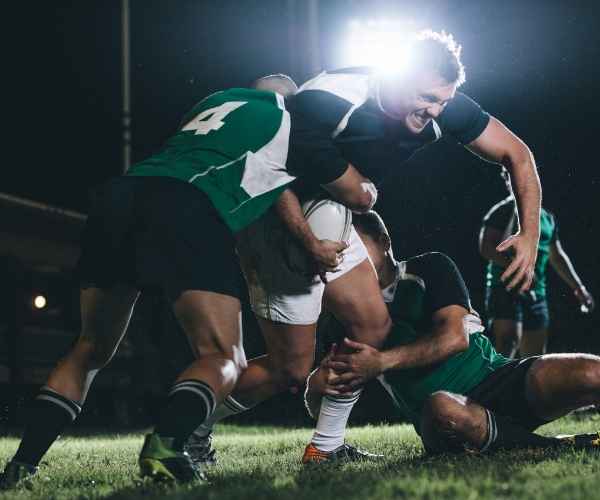
The Driving Tackle
The driving tackle is a variation on the head-on tackle. The difference is in the outcome.
With the driving tackle, the tackled player doesn’t end up immediately on the ground.
Instead, the defender pumps his legs while keeping low enough to hold the ball-carrier upright. The attacker is now driven backward. The roars of the crowd are in proportion to how far the ball carrier is pushed back.
The Hit
The “hit” is another variation on the head-on tackle. It refers to a tackle that has a big impact and knocks the breath out of the ball carrier.
Rugby players are taught how to be tackled. They brace their body in a way that is most likely to retain possession.
The biggest hits usually occur when the ball carrier isn’t set to accept the tackle.
To make a hit, defenders read the play and anticipate when the player they are marking is about to receive the ball.
The attacker is watching the ball, not the defender charging toward him.
If the defender makes a head-on tackle in the split second that the attacker takes the pass, the result can smash the attacker backwards to the ground.
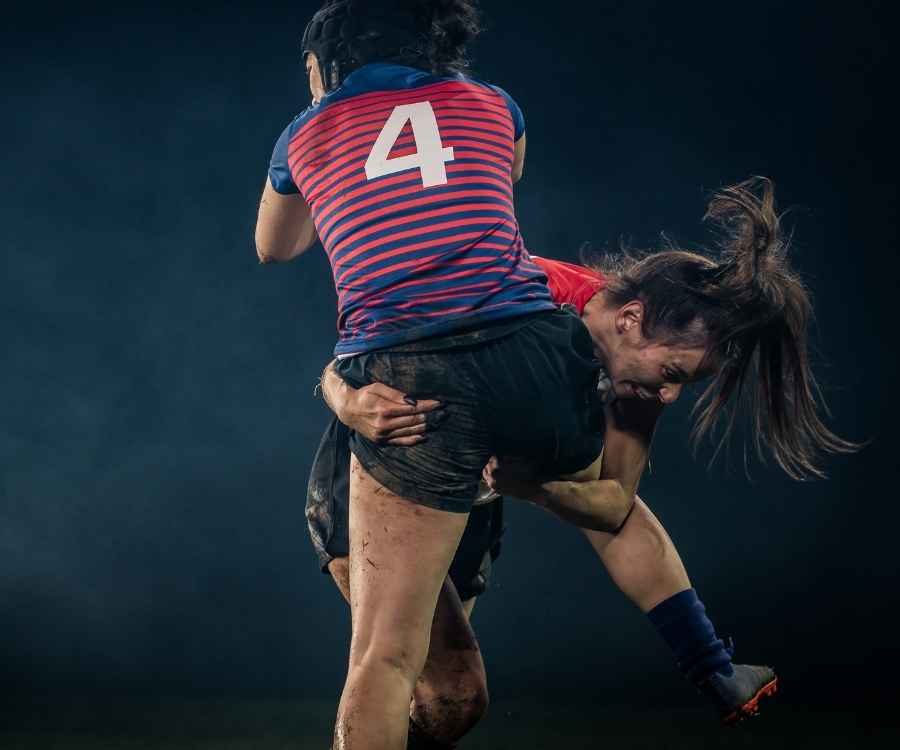
Stationary Tackle
This is another variant of the head-on tackle.
The stationary tackle occurs in a scenario when the defender is standing still, and the ball carrier is charging right at them.
If this is one forward charging at another, the defender should usually be able to stop the attacker in his tracks.
But it’s a different matter when a burly forward is charging at a scrumhalf. With a big weight difference, the attacker has all the advantages.
The smaller player has two options. Jump out of the way or execute a stationary tackle. The latter option involves bracing for impact, grabbing the ball carrier’s torso, and falling backward.
The goal is to bring the attacker to the ground. Even when the defender is essentially just a speed bump, the attackers’ progress is slowed enough for the cavalry to arrive.
Tackling A Hand-Off
Missing a tackle is bad. Getting knocked back by a ball carrier’s strong fend is worse.
There are two ways for defenders to deal with a hand-off.
One way is to grapple with the attacker’s fending arm and pull him closer into a half tackle. The goal is to get so close that a smother tackle can be made.
If defenders don’t get this right, they will simply be swatted away.
The second option is to bend low and tackle below the extended arm. The ball carrier will try and push the defender downward.
This becomes a question of which is stronger: the fend of one player or the leg-drive of the other. The picture below shows a defender going under the arm.
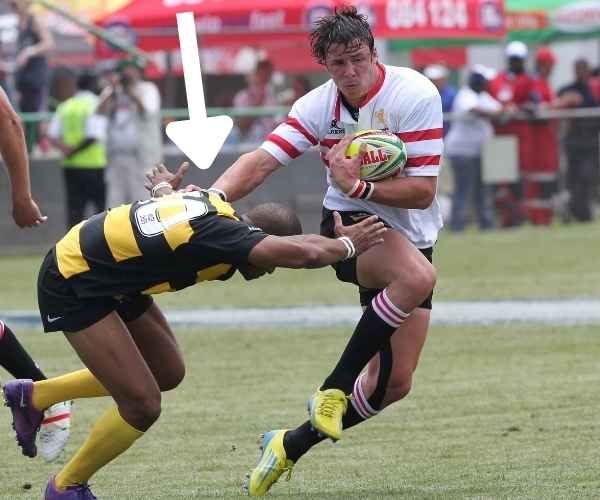
Tackle From Behind
This is one of the most iconic defensive moves in the sport.
We have a full article on tackling from behind in rugby.
I’ll summarize the main points here.
The defender chases behind the ball carrier to close the gap between them.
Launching forward, the defender aims to wrap his arms around the waist, hips, or upper thighs of the attacker.

Gravity and momentum bring the tackler’s arms down the legs of the attacker. This brings the ball carrier to the ground.
Younger players sometimes worry that they’ll get the heel of a boot in the face when tackling from behind. I’ve never seen this happen on the pitch in over forty years of being involved in rugby.
Remember that the attacker is running forward while the defender launches forward. If the attacker fails to wrap around the torso, he will certainly end up flailing on the ground.
But the ball carrier’s feet will be well past the point of touching the defender’s head.
The Ankle Tap Or Tap Tackle
We have a full article on ankle tap tackles in rugby.
These are last-ditch tackles from behind when the defender can’t get close enough to make a proper tackle.
Instead, the defender taps the ball carrier’s ankle hard enough to make them trip or stumble.
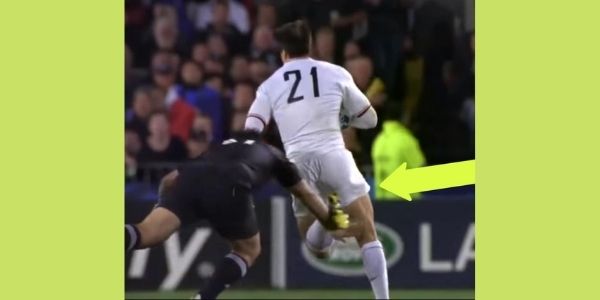
Chop Tackle
The chop tackle is also known in some regions as the grass cutter.
The term refers to tackling a player so low that the defender grasps and wraps around the ankles. The momentum stops the ball carrier dead and brings them down faster than higher tackles.
This toppling is where the name “chop” comes in. It’s like felling a tree.
The term “grass cutter” is used to describe how low the defender is to the ground when they make the tackle. They are skimming the top of the grass.
There has been some controversy over whether this tackling technique is allowed in the laws of rugby.
We go into this in detail (with pictures) in our article on whether chop tackles are legal.
The Dump Tackle
When this type of tackle is executed properly, the ball carrier is driven back, lifted off his feet, and landed with force on his back.
If the ball carrier lands on his neck or head, the tackler will be punished severely. The lightest judgment is a penalty. Yellow or red cards are also very likely.
We go into the techniques and outcomes in more detail in our separate article on dump tackles in rugby. We also explain how the laws have changed around them in recent years.